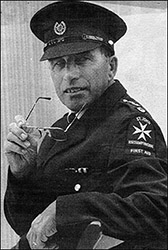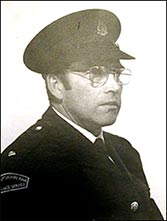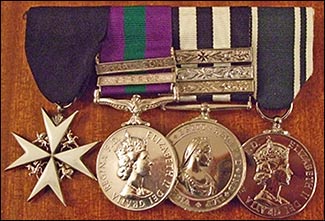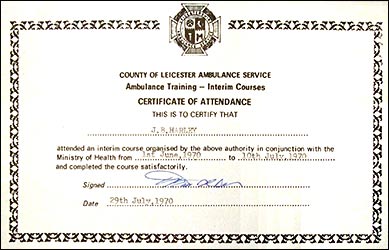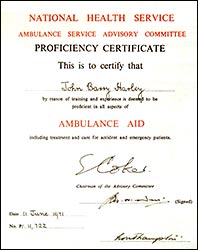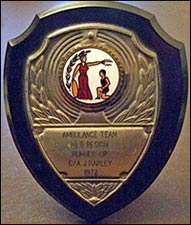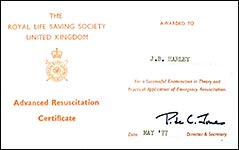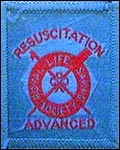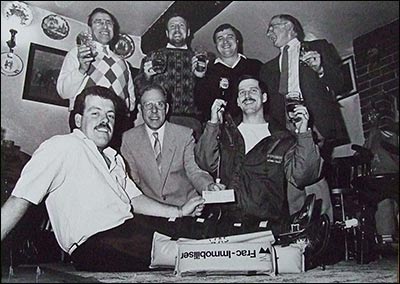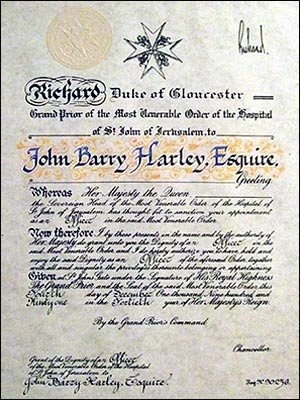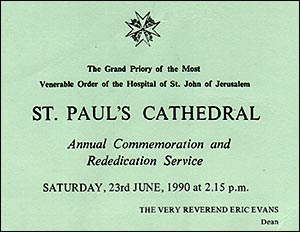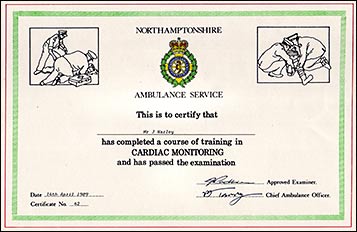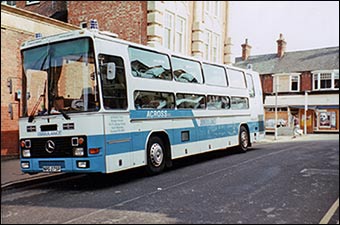|
||||||||||||||||||||||||||||||||||||
| From an interview, 15th February 2013, with Kay Collins |
||||||||||||||||||||||||||||||||||||
|
John Harley
|
||||||||||||||||||||||||||||||||||||
|
|
||||||||||||||||||||||||||||||||||||
In 1956 I got a job with Rushden Council laying slabs, kerbs and building manholes and anything that needed doing. I went home for my dinner one day and there was a telegram there telling me that I had to be back in the army. I’d already got my papers at home so I went down the Post Office and got ten shillings and took the train to Peterborough and up to Catterick. This was the Suez Crisis. I hadn’t been out long from the November to the September. And I got called up again. We then painted all our lorries sand coloured, got kitted out, shorts etc. then we then moved from Catterick down to a place called Ogborne St. George near Swindon. We moved down there waiting for boats to take us to Suez. We was such a big regiment, signals regiment that we couldn’t fit on one boat and so we were split in half and I was in the second half. The first wave got on the boat then we moved down to Southampton to get on the boat. They signed a truce or whatever they signed and so we never actually got on the boat. We went back to Ogborne St. George. Then we eventually dispersed from there, took all our lorries back to ordnance depots and then I was demobbed just in time to get home for Christmas 1956. By this time I had met Molly and we got married in 1957. When we got married we moved to Wymington. We lived there two or three years until we felt that we ought to have a place of our own. Harry Cave was building some bungalows at the allotments behind the Windmill Club, Alpine Road. It wasn’t a proper road then but allotments. The chap who had the land next to the bungalow, Jim Billett, worked on the ambulance. At this time I was working on various firms, tarmac firms, doing kerbs, building retaining walls and things like that. I built all the walls down Duck Street at this time. We raised the road by about four feet. You can walk along there now and the path near the butchers was one of the roads I worked on. As I say Jim Billett had this bit of allotment. He was an ambulance man and I used to talk to him. So I joined the St. John and got my first aid certificate and I applied for a job. I couldn’t get on Northamptonshire Ambulance so I went to the Northampton Borough.
Northampton Borough was a fire and ambulance service as well as a rescue service. We only worked in the borough but we went on the motorway at the request of the Northamptonshire Ambulance. I went for the interview and he said “provided you passed a medical you can start.” So I started in 1969 when I joined the Ambulance Station in Northampton. I was about three years on the roads and then I was promoted to leading ambulance man. But at that time if you were a leading ambulance man you came off the road and went in the control room. At Northampton Borough control room there was like two blocks of telephones and two desks; one the fire brigade and one the ambulance. The ambulance had white phones and the fire brigade had red phones. If there was a bad fire and a lot of calls were coming in some of the calls would be diverted to the ambulance ones. We used to have to take them. I also went on Competitions and I was the runner-up in the Southern Area. All the ambulances in the Southern Area, and just the odd point in it, so I was the runner-up.
Then in 1976 I was promoted to sub-officer like in old fire brigade days - that is what they were called. This is when I went back on the road. Then we moved to a new ambulance station up at Harborough Road. But prior to moving up to Harborough Road the fire service left the borough and went with the County so it was Northamptonshire Fire and Rescue Service. That was at Harborough Road Station. But while I was at Northampton Ambulance Station we made a video showing youngsters how to dial 999 and that was a great success.
In 1987 I moved to Rushden Ambulance Station, and lots of things happened at Rushden. We used to go in carnivals, switching on the lights, we had an ambulance in the parades all them sort of things. I can’t remember the date but we hadn’t got a defibrillator at Rushden as it was a small station. They couldn’t afford to put one on the station, so with the help of the Rotary Club and the street collection for the British Heart Foundation to raise money for this defibrillator for Rushden Station; between the Rotary, Rushden station and the British Heart Foundation collection we managed to raise about a thousand pounds to buy a defibrillator for Rushden Station. It is in the archives of the Telegraph. The Rotary used to have a meal every week at the Queen Vic to raise funds and we were invited to a meal one Friday and the defibrillator was presented to us for Rushden Station.
I retired from the service in 1995. As I say I was a member of St. John before I joined the ambulance and with that first aid certificate you got five shillings a week extra and you could wear a St. John’s badge on your arm. You were the bee’s knees if you’d got this certificate. When I joined the ambulance service we used to go on football matches, everybody did in them days, man carnivals. I was at Northampton then not at Rushden and I went on duty at the carnivals and all them sort of things. When I moved to Rushden there were about twelve people and I was in charge. I used to do the rotas and overtime sheets for Corby, Oundle, Wellingborough, Kettering and Rushden. So I used to do all the overtime sheets and rotas and what they were doing on sheets. I did this while I was doing all my Ambulance work as well. We wasn’t quite so busy then as we got to at the end. I really enjoyed what I done and everything.
One Sunday afternoon the crew were given the job, not me, to take this chap home and he’d got to go upstairs and I was out on a job and they said when you’re done there is a crew in Britain Road who have got to take this chap upstairs to bed. He’s a big chap and they want a hand So we said yes. When we got there they said there’s nobody here but the doors open. So I have a look round. We thought had we got the right address. Yes we’d got the right address. So I went upstairs and found a bed and we carried this chap upstairs and put him to bed. Well about an hour or so later these people came home and found a strange man in their bed. What’s going on. The police, ambulance service everybody. Well. This was the address that we had been given. So we found the right address and we had to go to the house apologise to the people, carry him down stairs put him in the ambulance and take him to the right address.
We had a 999 call from the doctor. “There’s a man lying on the bathroom floor.” We goes to the address. We couldn’t get in. We had saws and could get in anywhere but we couldn’t get in here. It was like a fortress. So I said “We can’t get in”. We were at the fire station at this time. “Well we’ll send the crew down to you and get the police down to you.” That happened eventually. The fire brigade tried all their methods of getting in. The police arrived at the same time. They were trying things as well. “We shall have to put the door in”. So they put the door in. They go to the bathroom, search the house; nobody there. Gets back on the phone and the radio. “Can you check with the doctor. We’ve broken into this house and there’s nobody lying on the bathroom floor. There’s nobody at this address.” So they ring the doctor and the doctor says, “Oh! I’ve given you the wrong address.” So there’s us, smashed all the door down, and it was the wrong house, so then we had to go charging up to the right address. He’d had a stroke. These things all happened. One day we went to these bungalows - the doctor had given us the address. The lady said “I’ve not got to go to the hospital.” So we said “Well we’d had this job from the doctor”. We said the doctor’s name which I can’t remember. “The doctor said you’ve got to go hospital.” So she said “Well I’d better come then. But I saw the doctor a few days ago but he never said anything about this.” We get this lady on the motor. So we get half way down and they radioed us. “Why haven’t you picked that lady up yet?” We said “We have, we’ve got her on the ambulance.” “You’d better get back up there they’ve given you the wrong number. You’ve got the wrong lady.” So we had to take this lady back and put the lady that we should have picked up in the ambulance. Fred Karno’s wasn’t it! |
||||||||||||||||||||||||||||||||||||
|
||||||||||||||||||||||||||||||||||||
John also helped with the later part of the History of the County Ambulance Service. |
||||||||||||||||||||||||||||||||||||
|
|
||||||||||||||||||||||||||||||||||||
|
|
||||||||||||||||||||||||||||||||||||
